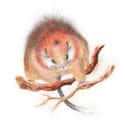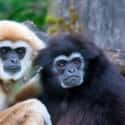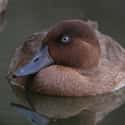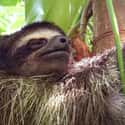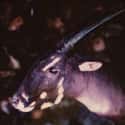-
(#1) Red Crested Tree Rat
- Santamartamys rufodorsalis
Population: Unknown, but in 1898, just two red-crested tree rats existed in captivity. For over a century, the species had not been spotted in the wild.
What Happened: In May 2011, a red-crested tree rat was spotted for the first time in 113 years by two biologists who were camping in a field. From this single sighting, it's impossible to say how many of these rats exist, but there's probably a handful – at least around Colombia's El Dorado Nature Reserve where the first little guy was found.
Because of the sighting, the rat was able to nab a listing as "critically endangered" rather than "extinct."
-
(#4) Hainan Black Crested Gibbon
Population: Less than 25
What Happened: The Hainan gibbon, which resides on the Hainan islands in the South China Sea, is the world's rarest primate. Over the last 50 years, deforestation has destroyed the gibbon's natural habitat. On top of that, Hainan gibbons frequently fall victim to poachers who sell them for food and traditional medicine or as pets. Currently, the species and its habitat are protected under law, but that's not enough to truly protect their population.
Something as simple as a disease or natural disaster could completely wipe them out.
-
(#5) Madagascar Pochard
- Aythya innotata
Population: As of 2014, there were just 25 individuals left in the world.
What Happened: Dubbed the world's rarest bird, the Madagascar pochard has suffered at the hands of humans, who have taken over their habitat in order to cultivate rice. According to BBC, humans have driven the birds to just a single wetland, which doesn't have enough food to sustain their population. The ducks primarily search for food at the bottom of lakes, but the lake they were pushed to was simply too deep for them to feed. Because of this, a whopping 96% of chicks die before they're three weeks old, but conservationists hope to restore a nearby lake that would be a more suitable habitat.
Like most herbivores, the diving ducks ensure the gentle balance of plant life in a lake's ecosystem. In some cases, an overgrowth of vegetation can lead to a lack of oxygen which kills off fish and aquatic life.
-
(#9) Three-toed sloth
- Bradypus
Population: 79
What Happened: Though the pygmy three-toed sloth has only been a recognized species since 2001, it has suffered a great deal since then. Pygmy three-toed sloths are only found on Isla Escudo de Veragus, where their already small habitat of mangrove forests is habitually destroyed. Sloths only descend from trees about once a week when they need to urinate or defecate. These slow, gentle creatures need trees to hide from predators.
Pygmy three-toed sloths are an ecosystem in of themselves, carrying a unique species of Trichophilus algae on their backs. As populations dwindle, this algae is also threatened.
-
(#8) Javan Rhinoceros
- Rhinoceros sondaicus
Population: 58 to 68 individuals
What Happened: Javan rhinos have been hunted to oblivion because their tusks warrant a hefty price tag on the black market. Currently, these rhinos are only found in Ujung Kulon National Park in Java, Indonesia. Javan rhinos are important to local ecosystems, where they increase biodiversity by munching on certain plant species.
The flora and fauna in these areas sustain other species, and if that delicate balance is altered, a whole lot more than just rhinos will suffer.
-
(#10) Saola
- Pseudoryx nghetinhensis
Population: between 70 to 700 (though current estimates believe the number is closer to the lower range).
What Happened: Saolas are important to biodiversity and remain a food source to even rarer animals of prey (think: tigers). Despite their rarity, many people in Laos and Vietnam depend on Saolas for meat. Unfortunately, it is these very people who caused their population to plummet.
Saolas suffered as Southeast Asia boomed with development and climate change reared its ugly head. The species lives mostly in wet forests at low elevations. In places like Vietnam, these areas are now densely populated, while in places like Laos, these areas no longer exist. Saolas were never really used in Chinese medicine, so they don't carry a hefty price tag for poachers; unfortunately, saolas are frequently killed in the crossfire and caught in traps meant for other animals. Currently, their population is so small that two of their biggest threats are inbreeding or not being able to breed because of isolation.
New Random Displays Display All By Ranking
About This Tool
Due to the species' own reasons or being affected by human activities or natural disasters, there are many wild animal species in the world that are facing the danger of extinction. There are more than 100 kinds of vertebrates in the endangered state in the world, about 14 species are caused by natural evolution, and the rest are caused by man-made factors.
Wild animals have become victims of the development of human society, many ancient animal species, which were originally huge in number, went extinct in a short period of time. It is urgent to protect the habitat and restore the damaged ecosystem. You could know 12 endangered animals in this random tool that are fewer than 100 in the world.
Our data comes from Ranker, If you want to participate in the ranking of items displayed on this page, please click here.










